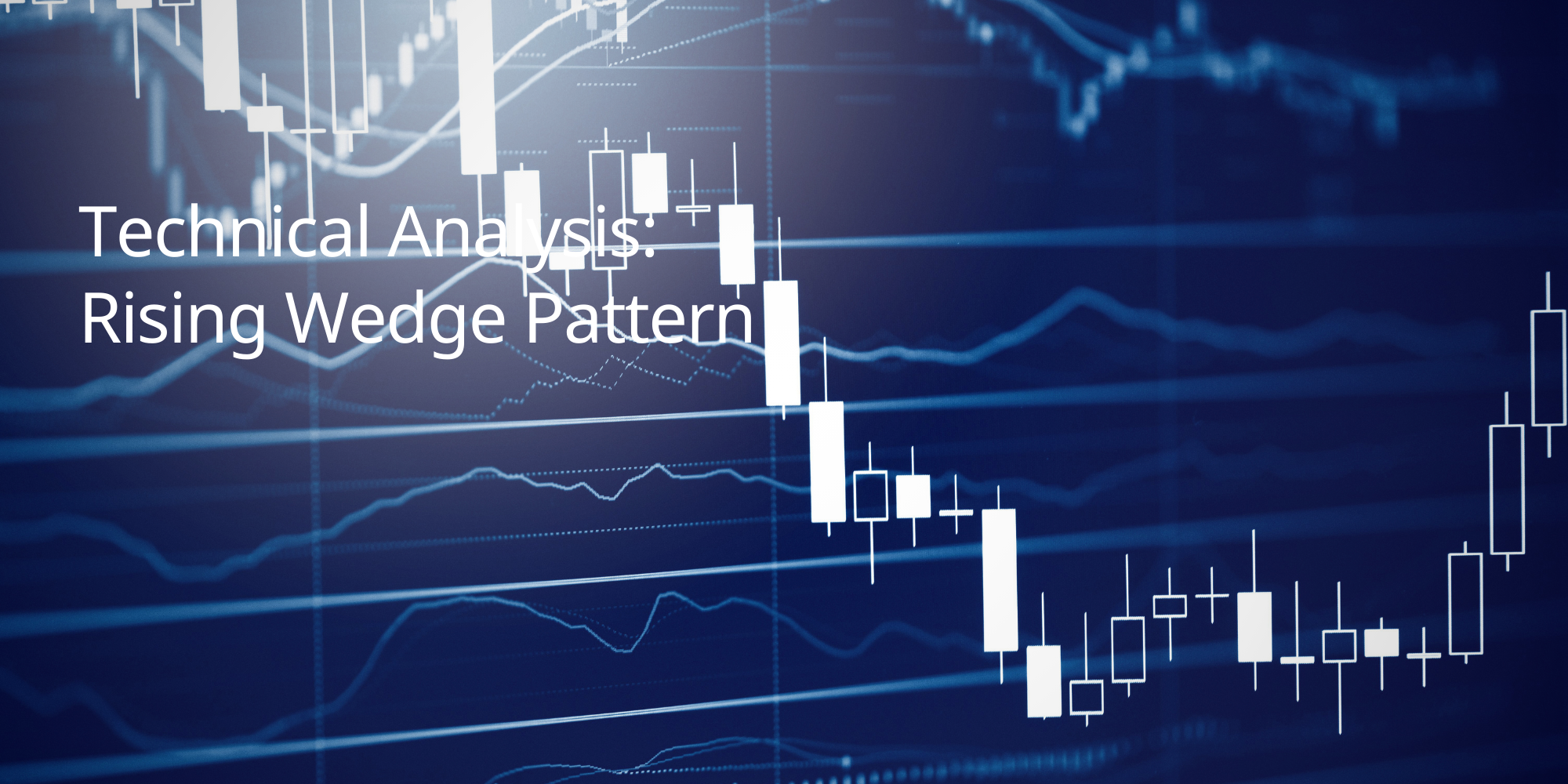Rising Wedge Pattern: A Bearish Reversal Signal
The Rising Wedge pattern is a bearish chart formation that often signals the end of an uptrend and the potential beginning of a downtrend. It forms when price moves upward within a narrowing range, characterised by higher highs and higher lows converging toward a single point.
In this guide from TradeSmart, you’ll learn:
- What the Rising Wedge pattern is and how it forms
- The psychological and technical implications behind the pattern
- How to confirm the pattern using volume and breakout direction
- Effective trading strategies for entering short positions or locking in profits
Whether you’re looking to short the market or protect gains, recognising a Rising Wedge early can give you a valuable edge.
What is the Rising Wedge Pattern?
The Rising Wedge is a bearish reversal pattern that typically forms after an uptrend. It’s characterized by two converging upward-sloping trendlines, with the price making higher highs and higher lows, but with the price range narrowing. This suggests that upward momentum is weakening and a reversal to the downside could be imminent.
Key Characteristics:
- Two Upward-Sloping Trendlines: The pattern is formed by two trendlines that are both sloping upwards, but converging towards each other.
- Higher Highs and Higher Lows: The price makes higher highs and higher lows within the pattern, but the distance between the highs and lows is decreasing.
- Decreasing Volume: Volume typically decreases as the pattern matures, indicating weakening buying pressure.
- Breakdown: A breakdown below the lower trendline confirms the pattern and signals a potential trend reversal to the downside.
How the Rising Wedge Pattern Works
The Rising Wedge pattern suggests that buyers are losing momentum and sellers are starting to gain control. The narrowing price range indicates that the uptrend is becoming weaker, and a breakdown below the lower trendline confirms the reversal and signals a potential new downtrend.
Trading the Rising Wedge Pattern
The Rising Wedge pattern can provide valuable signals for traders who are looking for potential trend reversals. Here’s how to trade this pattern effectively:
- Identify the Pattern: Look for an uptrend where the price is making higher highs and higher lows, but the distance between the highs and lows is narrowing. This forms a rising wedge shape with two converging upward-sloping trendlines.
- Confirm the Breakdown: Wait for the price to break decisively below the lower trendline of the wedge. This breakdown signals a potential reversal of a downtrend.
- Consider Volume: Look for decreasing volume as the wedge pattern forms. This can indicate weakening momentum and increase the likelihood of a breakdown.
- Enter a Short Position: Once the breakdown is confirmed, consider entering a short position (selling the asset or opening a CFD short trade).
- Set a Stop-Loss Order: Place a stop-loss order above the upper trendline of the wedge or the most recent high within the wedge. This will help limit your potential losses if the price unexpectedly reverses back to the upside.
- Consider a Profit Target: The potential price target for a Rising Wedge breakdown can be estimated by measuring the distance from the highest high within the wedge to the breakdown point and projecting that distance downwards from the breakdown point.
Example:
Imagine a stock that has been in an uptrend. The price starts to form a Rising Wedge pattern, with higher highs and higher lows, but the price range is narrowing. The volume is also decreasing. When the price breaks down below the lower trendline of the wedge on increased volume, it confirms the pattern and signals a potential short-selling opportunity.
Limitations of the Rising Wedge Pattern
While the Rising Wedge pattern can be a valuable tool for traders, it’s important to be aware of its limitations:
- Subjectivity in Identification: Identifying rising wedge patterns can be subjective, as the trendlines and the breakdown point might not always be clear-cut. This can lead to different interpretations and potentially inaccurate trading signals.
- Not Always a Reversal Signal: While typically considered a bearish reversal pattern, rising wedges can sometimes act as continuation patterns, especially when they form within a downtrend. This can lead to false signals if traders don’t consider the broader market context.
- Similarity to Other Patterns: The Rising Wedge can resemble other chart patterns, such as ascending triangles. It’s important to carefully analyze the pattern’s characteristics, including the angle of the trendlines and the volume pattern, to avoid misidentification.
- False Signals: Like any technical indicator, the Rising Wedge pattern can generate false signals. The price might break down below the lower trendline and then quickly reverse back up, leading to a false breakdown and potential losses for traders.
Mitigating the Limitations
To overcome these limitations, traders can:
- Combine with Other Indicators: Use the Rising Wedge pattern in conjunction with other technical indicators, such as moving averages, trend lines, or momentum oscillators, to confirm signals and filter out false signals.
- Consider Market Context: Always interpret the pattern’s signals in the context of the overall market environment. Consider factors such as news events, economic data releases, and the broader market trend when making trading decisions.
- Practice Risk Management: Use appropriate risk management techniques, such as stop-loss orders and position sizing, to limit potential losses.
TradeSmart encourages traders to use the Rising Wedge pattern as part of a comprehensive trading strategy. By understanding its limitations and combining it with other analytical tools, traders can make more informed decisions and improve their trading outcomes.
Identifying and Understanding the Rising Wedge Pattern
The Rising Wedge pattern is a bearish reversal pattern that can appear in various markets and timeframes. Here’s how to identify it and understand its implications:
Identifying the Pattern
- Converging Trendlines: Look for two upward-sloping trendlines that converge as they extend to the right. The lower trendline should be steeper than the upper trendline.
- Narrowing Price Range: The price action within the wedge should be making higher highs and higher lows, but the distance between the highs and lows should be decreasing. This creates the characteristic “wedge” shape.
- Decreasing Volume: Ideally, volume should decrease as the pattern matures, indicating weakening momentum and buying pressure.
Frequency of Occurrence
The frequency of Rising Wedge patterns can vary depending on:
- Market Conditions: Rising wedges are more common in markets with strong upward trends, as they often form as a trend is nearing its peak.
- Timeframe: They can occur on any timeframe, but they are more commonly observed on longer-term charts (e.g., daily, weekly) where broader trend reversals are more likely to occur.
- Asset Class: Rising wedges can appear in various asset classes, including stocks, currencies, and commodities.
Rising Wedge Patterns in Different Trend Contexts
While the Rising Wedge is typically considered a bearish reversal pattern, it can also appear within a broader trend, either an uptrend or a downtrend. The interpretation of the pattern depends on the context in which it forms.
Rising Wedge in an Uptrend
When a Rising Wedge forms within an uptrend, it’s usually a bearish signal, suggesting that the uptrend is losing momentum and could reverse to the downside. The narrowing price range and decreasing volume within the wedge indicate weakening buying pressure.
Rising Wedge in a Downtrend
When a Rising Wedge forms within a downtrend, it’s usually a bearish continuation pattern. It suggests that the downtrend is likely to resume after a brief pause or corrective rally. The rising wedge in this context represents a weak attempt by buyers to reverse the trend, but the decreasing volume and eventual breakdown below the lower trendline confirm that sellers are still in control.
Conclusion
The Rising Wedge pattern is a powerful indicator of potential trend reversal, particularly in overextended uptrends. By understanding its structure and confirmation signals, traders can anticipate market shifts, exit long positions strategically, or initiate well-timed short trades.
At TradeSmart, we provide everything you need to trade this pattern with confidence:
- Identify and confirm Rising Wedge patterns on MT4 and MT5 platforms
- Understand the breakout potential and align with other indicators
- Build and backtest strategies around wedge breakdowns
- Apply strong risk management techniques to protect your capital
Ready to take advantage of bearish reversal signals?
- Open a TradeSmart account and access advanced technical tools
- Practice wedge analysis with a risk-free demo account
- Start live trading with just a $50 minimum deposit
Visit TradeSmart.com today and unlock the power of the Rising Wedge pattern in your trading strategy.





